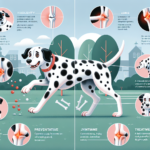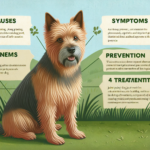Dalmatian Joint Pain: Causes, Symptoms, Prevention, and Treatment

Introduction
The Dalmatian is a distinctive and well-loved breed, known for its unique spotted coat and energetic personality. Originating from the historical region of Dalmatia, which is part of modern-day Croatia, Dalmatians have a rich history as carriage dogs, firehouse mascots, and even performers in circuses. Their striking appearance and lively demeanor make them a popular choice among dog enthusiasts.
However, like many purebred dogs, Dalmatians are prone to certain health issues. Among these, joint pain is a significant concern that can affect their quality of life. Understanding the causes, symptoms, prevention, and treatment of joint pain in Dalmatians is crucial for ensuring their well-being.
Joint health is particularly important for Dalmatians due to their active nature. These dogs are known for their high energy levels and love for physical activities, which can put additional stress on their joints. Maintaining joint health is essential to keep them active and happy throughout their lives.
Breed-Specific Joint Pain Risks
Genetic Predisposition
Dalmatians, like many other breeds, have a genetic predisposition to certain joint-related issues. Hip dysplasia, a condition where the hip joint doesn’t fit properly into the hip socket, is relatively common in Dalmatians. This can lead to arthritis and significant pain over time. Elbow dysplasia, another genetic condition, affects the elbow joints and can cause similar issues.
Age-Related Risks
As Dalmatians age, the risk of developing joint pain increases. While younger Dalmatians may show few signs of joint issues, older dogs are more likely to experience arthritis and other degenerative joint diseases. It’s important for owners to be aware of these age-related risks and monitor their dogs for any signs of discomfort as they grow older.
Activity Level and Joint Stress
Dalmatians are known for their high energy levels and need for regular exercise. While this is beneficial for their overall health, it can also contribute to joint stress. Activities such as running, jumping, and playing can put additional strain on their joints, especially if they are not performed correctly or if the dog is overweight. It’s important to balance their activity levels to prevent excessive joint stress.
Common Symptoms of Joint Pain in Dalmatians
General Symptoms
Owners should be vigilant for common symptoms of joint pain in their Dalmatians. These can include:
- Limping or favoring one leg
- Stiffness, especially after rest
- Reluctance to move or play
- Difficulty climbing stairs or jumping
- Swelling around the joints
- Changes in behavior, such as increased irritability
Breed-Specific Symptoms
In Dalmatians, some symptoms may be more noticeable due to their active nature. For example, a sudden decrease in their usual energy levels or reluctance to engage in activities they previously enjoyed can be a sign of joint pain. Additionally, their short coat makes it easier to spot swelling or changes in the appearance of their joints.
When to Consult a Vet
If you notice any of the above symptoms in your Dalmatian, it’s important to consult a veterinarian. Early diagnosis and treatment can help manage joint pain and prevent further deterioration. Regular veterinary check-ups are also essential for monitoring your dog’s joint health and catching any issues early.
Preventive Measures for Joint Health
Exercise Recommendations
Regular exercise is crucial for maintaining joint health in Dalmatians, but it should be done in a way that minimizes joint stress. Low-impact activities such as swimming and walking are excellent choices. Avoid high-impact activities like excessive running or jumping, especially on hard surfaces. Consistent, moderate exercise helps keep the joints flexible and muscles strong, which supports joint health.
Dietary Suggestions
A balanced diet is essential for joint health. Consider incorporating foods rich in omega-3 fatty acids, such as fish oil, which have anti-inflammatory properties. Glucosamine and chondroitin supplements can also support joint health by promoting cartilage repair and reducing inflammation. Always consult your veterinarian before adding supplements to your dog’s diet.
Weight Management
Maintaining a healthy weight is crucial for reducing joint stress. Excess weight puts additional pressure on the joints, exacerbating pain and increasing the risk of joint-related issues. Monitor your Dalmatian’s weight and adjust their diet and exercise routine as needed to keep them at a healthy weight.
Early Screening and Monitoring
Early screening for joint issues can help catch problems before they become severe. Regular veterinary check-ups should include joint assessments, especially as your Dalmatian ages. X-rays and other diagnostic tools can help identify issues like hip or elbow dysplasia early on, allowing for timely intervention.
Treatment Options for Joint Pain
Non-Surgical Treatments
Non-surgical treatments are often the first line of defense against joint pain. These can include:
- Medications: Anti-inflammatory drugs and pain relievers can help manage pain and reduce inflammation.
- Physical Therapy: Exercises and therapies designed to improve joint function and reduce pain.
- Lifestyle Adjustments: Modifying your dog’s activity levels and environment to reduce joint stress.
Surgical Options
If non-surgical treatments are not effective, surgical options may be considered. These can include:
- Hip Replacement: Replacing the damaged hip joint with an artificial one.
- Arthroscopy: A minimally invasive procedure to clean out the joint and remove damaged tissue.
- Joint Fusion: Fusing the joint to reduce pain and improve stability.
Alternative Therapies
Alternative therapies can also be beneficial for managing joint pain in Dalmatians. These can include:
- Acupuncture: Using needles to stimulate specific points on the body to reduce pain and inflammation.
- Hydrotherapy: Water-based exercises that reduce joint stress while improving strength and flexibility.
- Massage: Therapeutic massage to improve circulation and reduce muscle tension around the joints.
Lifestyle and Management Tips
Daily Care Routine
A consistent daily care routine can help manage and alleviate joint pain in Dalmatians. This can include:
- Regular, low-impact exercise
- A balanced diet with joint-supporting supplements
- Weight management through portion control and regular exercise
- Regular veterinary check-ups for early detection of joint issues
Modifying the Home Environment
Making your home more comfortable for a dog with joint pain can significantly improve their quality of life. Consider the following modifications:
- Installing ramps to help them navigate stairs
- Providing orthopedic beds for better joint support
- Using non-slip mats to prevent falls on slippery surfaces
Long-Term Management
Long-term management strategies are essential for keeping your Dalmatian active and happy despite joint pain. These can include:
- Consistent monitoring of their condition and adjusting treatments as needed
- Maintaining a regular exercise routine to keep joints flexible
- Continuing with dietary supplements and a balanced diet
- Regular veterinary check-ups to monitor joint health
FAQs About Dalmatians and Joint Pain
What are the early signs of joint pain in Dalmatians?
Early signs of joint pain in Dalmatians can include limping, stiffness, reluctance to move, and changes in behavior such as increased irritability or decreased activity levels.
Can joint pain in Dalmatians be prevented?
While it may not be possible to completely prevent joint pain, taking preventive measures such as regular exercise, a balanced diet, weight management, and early screening can significantly reduce the risk and severity of joint issues.
Are there specific exercises that are better for Dalmatians with joint pain?
Low-impact exercises such as swimming and walking are ideal for Dalmatians with joint pain. These activities help maintain joint flexibility and muscle strength without putting excessive stress on the joints.
What dietary supplements are recommended for joint health in Dalmatians?
Supplements such as glucosamine, chondroitin, and omega-3 fatty acids are commonly recommended for supporting joint health. Always consult your veterinarian before adding any supplements to your dog’s diet.
When should I consider surgery for my Dalmatian’s joint pain?
Surgery should be considered if non-surgical treatments are not effective in managing your Dalmatian’s joint pain. Consult with your veterinarian to determine the best course of action based on your dog’s specific condition.
Conclusion
Joint pain is a significant concern for Dalmatians, but with proper understanding and management, it is possible to maintain their quality of life. By recognizing the causes, symptoms, and preventive measures, owners can take proactive steps to support their Dalmatian’s joint health. Regular veterinary check-ups, a balanced diet, appropriate exercise, and weight management are key components of a comprehensive joint health strategy. If joint pain does occur, a range of treatment options, including non-surgical treatments, surgical interventions, and alternative therapies, can help manage the condition effectively. By staying informed and vigilant, Dalmatian owners can ensure their beloved pets remain active and happy throughout their lives.



